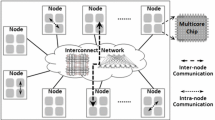Abstract
The two-way stripes partition mapping and the greedy assignment mapping are proposed to map finite element graphs composed of a number of rectilinear four-node elements on hypercubes. The two-way stripes partition mapping is a two-phase mapping approach. In the first phase a two-way stripes partition heuristic is used to lower the communication cost. In the second phase the load transfer heuristic is used to balance the computational load among processors. The greedy assignment mapping tries to minimize the communication cost and balance the computational load of processors simultaneously. Our simulation results show that the speedups for the two-way stripes partition mapping are better than those for the greedy assignment mapping when the load balancing criterion is achieved in both approaches (that is, the number of nodes in each processor is at most one more than the number of nodes in any other processor). However, the greedy approach performs well at a much lower cost.
Similar content being viewed by others
References
Aykanat, C., Ozguner, F., Martin, S., and Doraivelu, S.M. 1987. Parallelization of a finite element application program on a hypercube multiprocessor. In Conf. Proc.—The Second Hypercube Multiprocessor Conf., pp. 662–673.
Berger, M.J., and Bokhari, S.H. 1987. A partitioning strategy for nonuniform problems on multiprocessors. IEEE Trans. Comps., C-36, 5 (May): 570–580.
Bhuyan, L.N., and Agrawal, D.P. 1984. Generalized hypercube and hyperchannel structures for a computer network. IEEE Trans. Comps., C-33: 323–333.
Bokhari, S.H. 1981. On the mapping problem. IEEE Trans. Comps., C-30: 207–214.
Chan, T.F., and Saad, Y. 1986. Multigrid algorithms on the hypercube multiprocessors. IEEE Trans. Comps., C-35: 969–977.
Garey, M.R., and Johnson, D.S. 1979. Computers and Intractability: A Guide to the Theory of NP-Completeness. Freeman, San Francisco.
Hayes, J., and Mudge, T. 1986. Architecture of a hypercube supercomputer. In Conf. Proc.—The 16th Internat. Conf. on Parallel Processing (St. Charles, Ill., Aug.), pp. 653–660.
Harary, F. 1969. Graph Theory. Addison-Wesley, Reading, Mass.
Jordan, H. 1978. A special purpose architecture for finite element analysis. In Conf. Proc.—The 4th Internat. Conf. on Parallel Processing, pp. 263–266.
Lapidus, L., and Pinder, G.F. 1983. Numerical Solution of Partial Differential Equations in Science and Engineering. Wiley, New York.
Pease, M.C. 1977. The indirect binary n-cube multiprocessor array. IEEE Trans. Comps., C-26: 458–473
Sadayappan, P., and Ercal, F. 1987. Nearest-neighbor mapping of finite element graphs on processor meshes. IEEE Trans. Comps., C-36, 12 (Dec.): 1408–1424.
Seitz, C.L. 1985. The Cosmic Cube. CACM, 28: 22–33.
Author information
Authors and Affiliations
Additional information
The work of this author was supported in part by NSF under contract CCR-9110812.
Rights and permissions
About this article
Cite this article
Chung, YC., Ranka, S. Mapping finite element graphs on hypercubes. J Supercomput 6, 257–282 (1992). https://doi.org/10.1007/BF00155802
Issue Date:
DOI: https://doi.org/10.1007/BF00155802




